Pasta Primavera
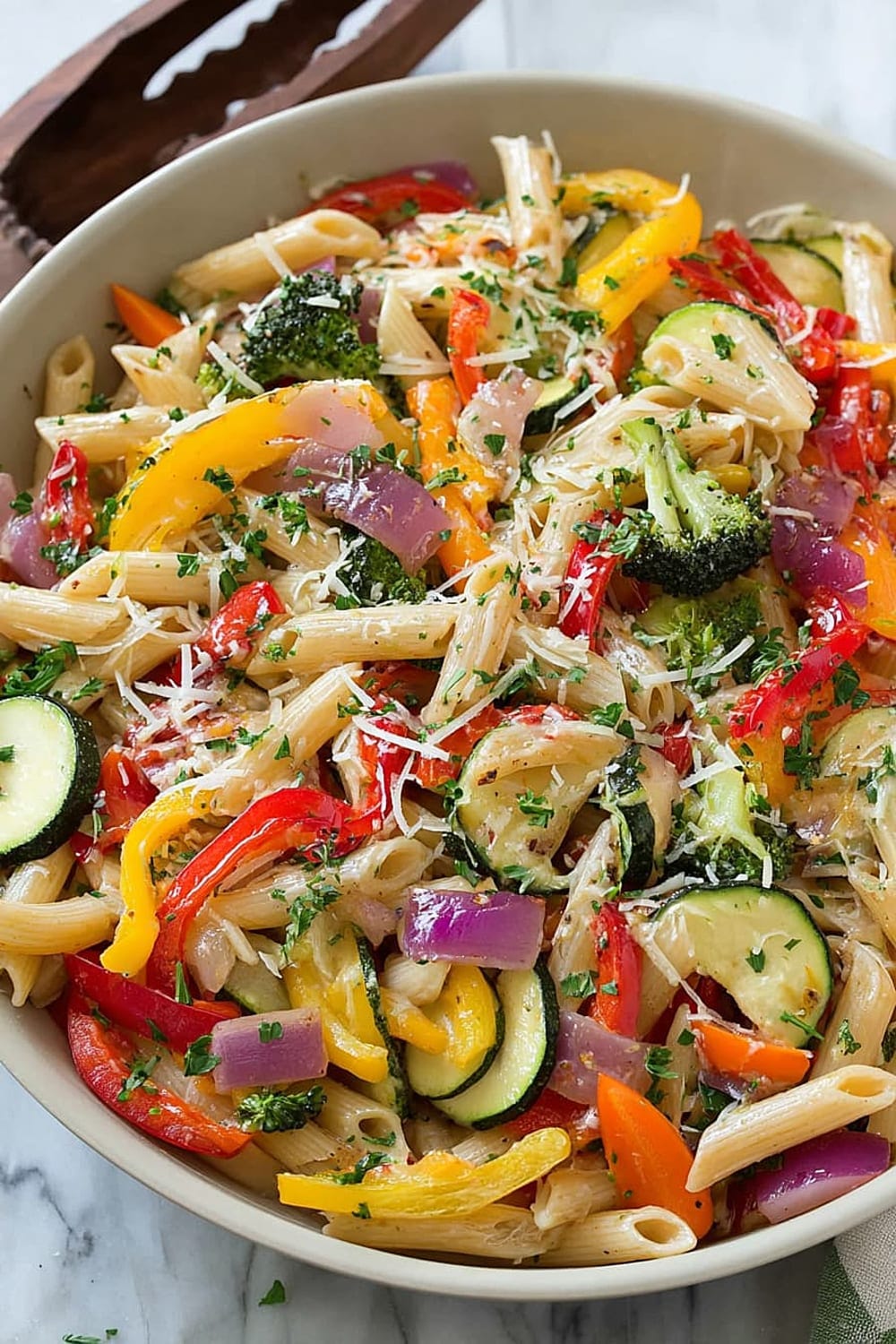
This pasta primavera is basically the vegetable kingdom’s way of showing off, and honestly, they deserve the spotlight.
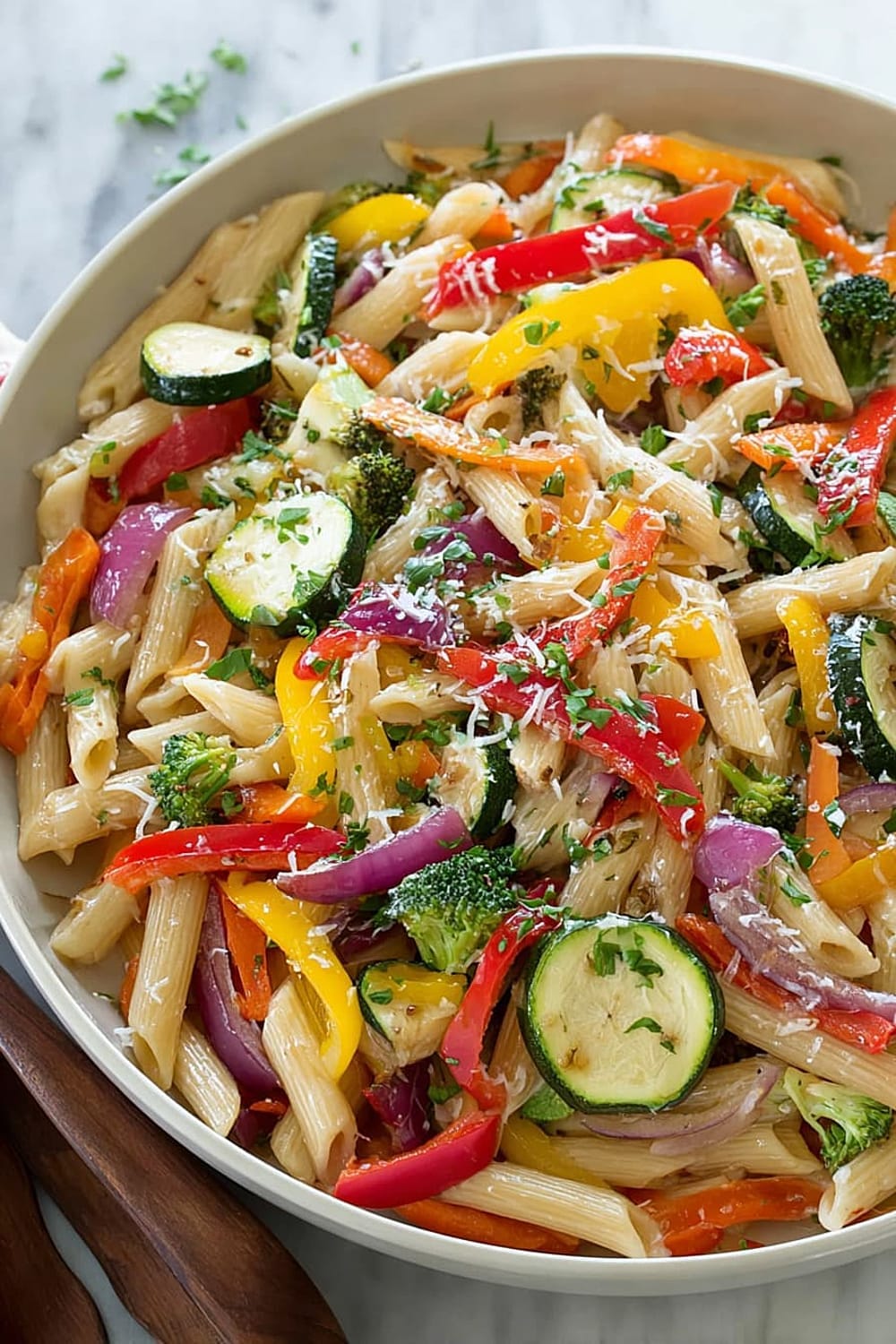
Picture this: perfectly tender penne pasta tossed with a rainbow of crisp-tender vegetables that somehow manage to taste like sunshine and good life choices rolled into one dish.
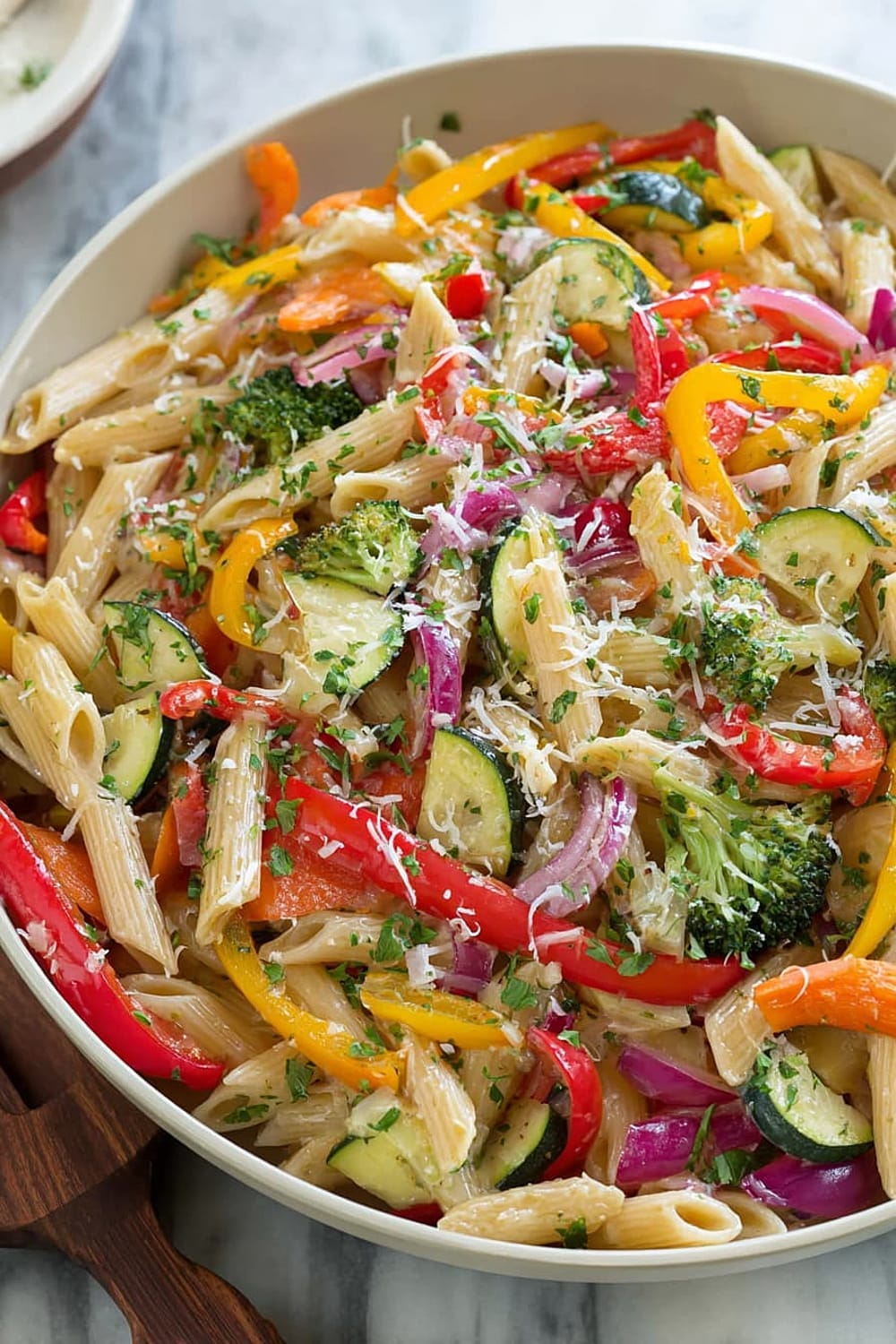
The magic happens when those fresh vegetables hit the hot olive oil and start sizzling – that’s when your kitchen transforms into an Italian trattoria and you start feeling like a culinary genius.
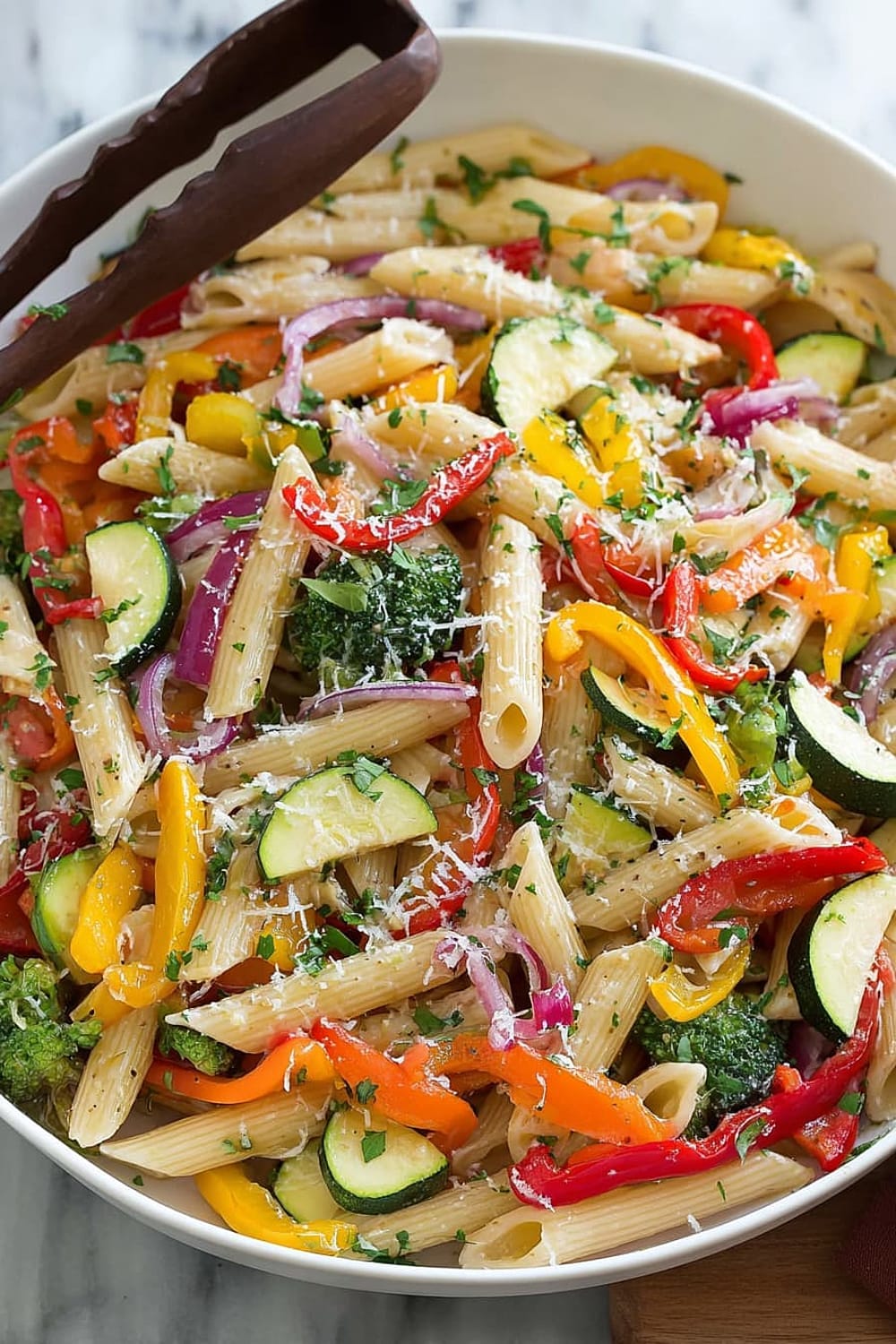
What makes this recipe absolutely brilliant is how it turns “eating your vegetables” from a chore into the main event, with each bite delivering a perfect balance of textures and flavors.
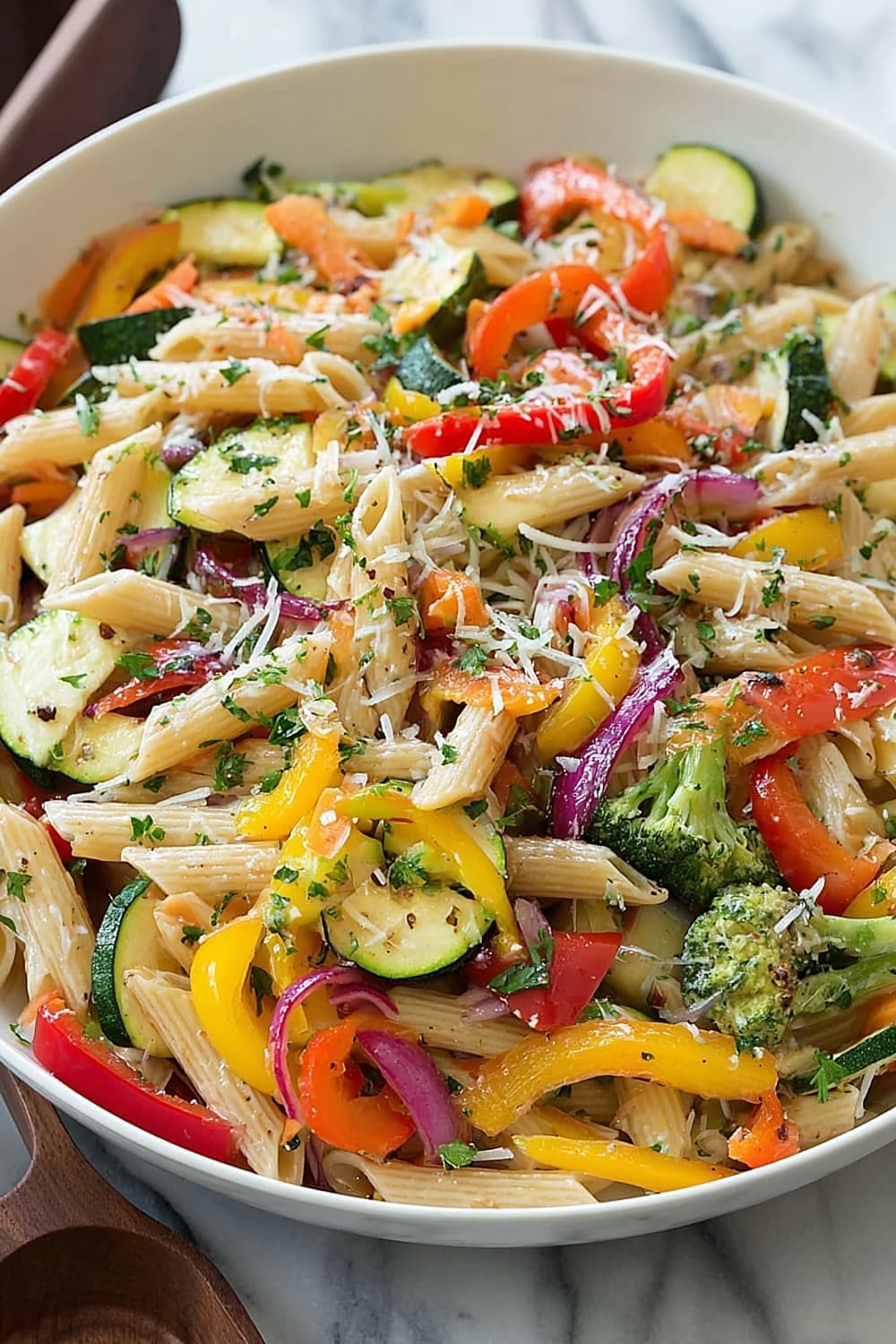
The bright lemon juice and fresh parmesan create this incredible sauce that clings to every piece of pasta and vegetable, making sure no bite is ever boring.
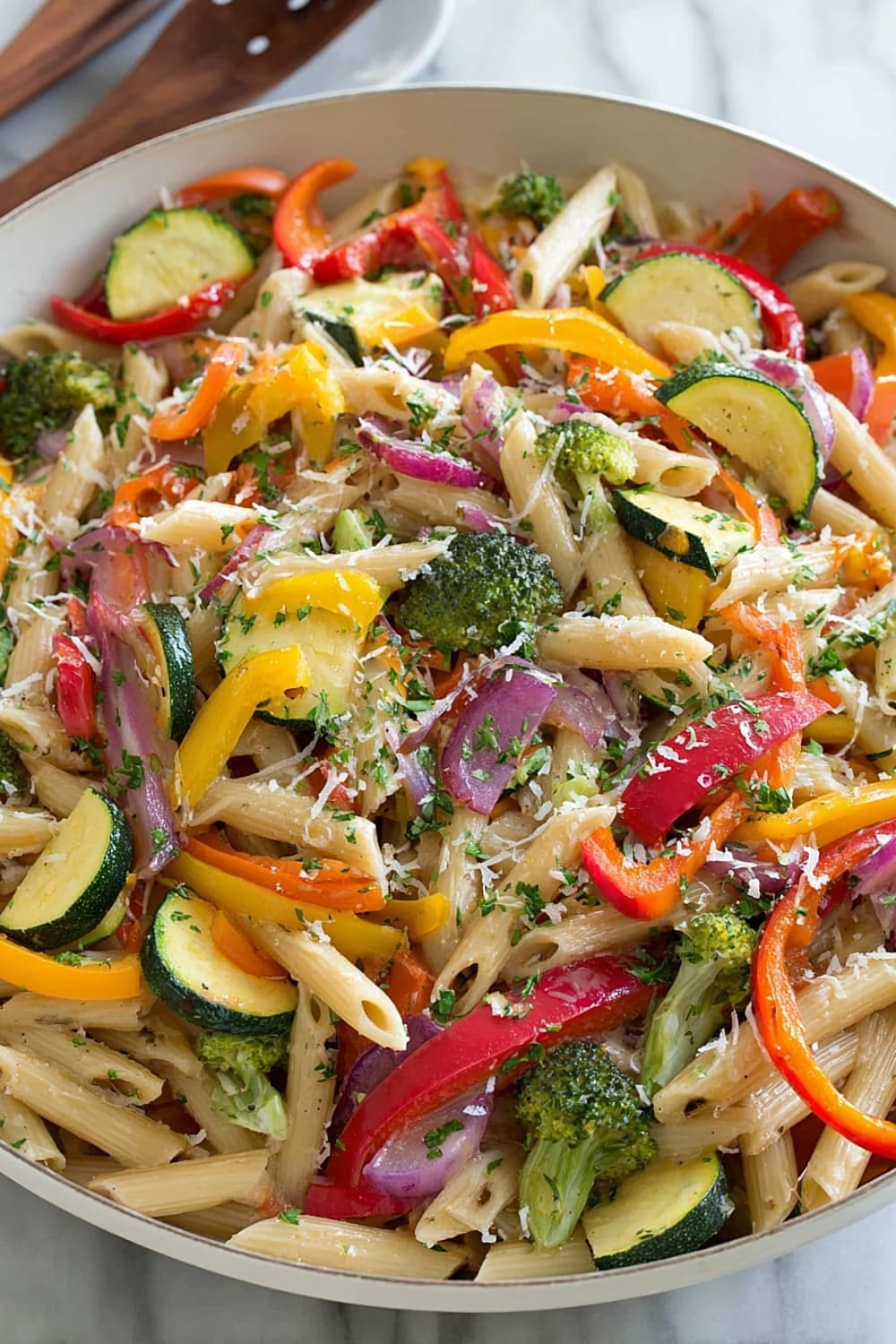
Plus, this is the kind of recipe that makes you look like you have your life together, even if you’re just trying to clean out your vegetable drawer before everything goes bad.
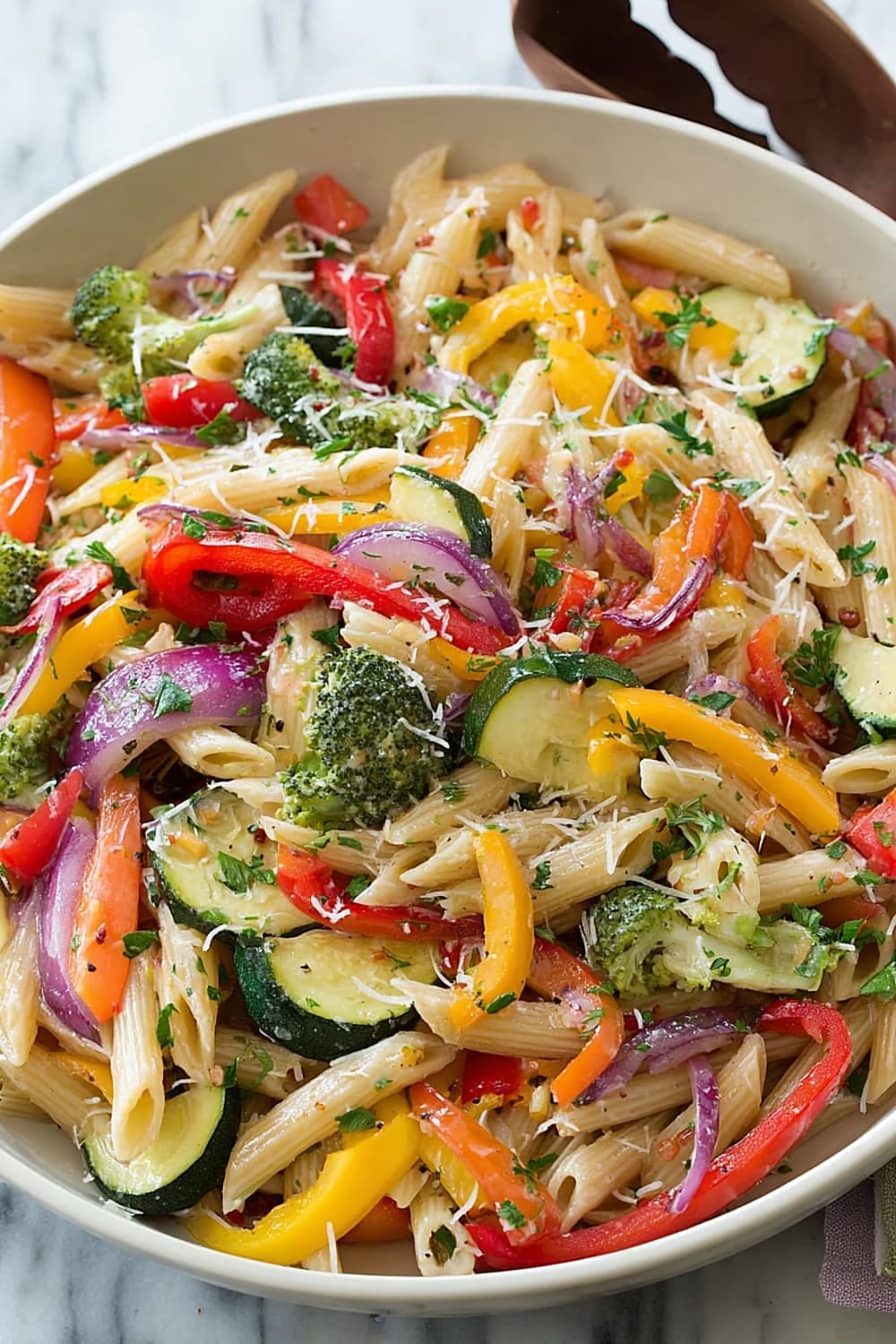
Ingredients
For the pasta base
- 10 oz. dry Barilla Penne Pasta
- Salt for pasta water
- 1 /2 cup pasta water (reserved from cooking)
For the vegetable medley
- 1 /4 cup extra virgin olive oil
- 1 /2 medium red onion, sliced thin
- 1 large carrot, peeled and sliced into matchsticks
- 2 cups fresh broccoli florets, cut into matchsticks
- 1 medium red bell pepper, sliced into matchsticks
- 1 medium yellow squash, sliced into quarter portions
- 1 medium zucchini, sliced into quarter portions
- 3-4 cloves fresh garlic, minced
- 1 cup (heaping) grape tomatoes, halved lengthwise
For the finishing touches
- 2 tsp dried Italian seasoning
- 2 Tbsp fresh lemon juice
- 1 /2 cup freshly shredded parmesan cheese, divided
- 2 Tbsp fresh parsley, chopped fine
Instructions
Prepare the pasta
- 1 Bring a large pot of water to a rolling boil over high heat. Add 1 tablespoon salt to the water – it should taste like the sea. Cook the penne pasta according to package directions until al dente, typically 10-12 minutes. Before draining, reserve 1/2 cup of the starchy pasta water using a heat-proof measuring cup. This pasta water is liquid gold for creating the perfect sauce consistency.
- 2 Drain the pasta in a colander and give it a gentle shake to remove excess water, but don’t rinse it. The residual starch on the pasta will help the sauce cling beautifully to every piece.
Cook the vegetables
- 3 While the pasta cooks, heat 1/4 cup olive oil in a 12-inch deep skillet over medium-high heat until the oil shimmers but doesn’t smoke. The large surface area is crucial for properly sautéing all these vegetables without overcrowding.
- 4 Add the sliced red onion and carrot matchsticks to the hot oil. Sauté for exactly 2 minutes, stirring frequently with a wooden spoon or silicone spatula. The onions should start to soften and become fragrant, while the carrots begin to brighten in color.
- 5 Add the broccoli florets and red bell pepper strips to the skillet. Continue sautéing for another 2 minutes, tossing everything together. The vegetables should start to develop a slight char on the edges while remaining crisp-tender – this is where the flavor magic happens.
- 6 Introduce the yellow squash and zucchini quarters to the pan. Sauté for 2-3 minutes until the vegetables have nearly softened but still retain a slight bite. They should be vibrant in color and tender enough to pierce easily with a fork, but not mushy.
Finish and combine
- 7 Add the minced garlic, halved grape tomatoes, and 2 teaspoons Italian seasoning to the vegetable mixture. Sauté for 2 minutes longer, stirring constantly to prevent the garlic from burning. The tomatoes should start to release their juices and the garlic should become incredibly fragrant.
- 8 Transfer the entire vegetable mixture into the now-empty pasta pot or a large serving bowl. Add the drained pasta and drizzle with 2 tablespoons fresh lemon juice. Season with additional salt to taste – start with 1/2 teaspoon and adjust as needed.
- 9 Toss everything together while gradually adding the reserved pasta water, 2 tablespoons at a time, until the mixture is glossy and well-coated. The pasta water will help create a light sauce that binds everything together without being heavy.
- 10 Add 1/4 cup parmesan cheese and the chopped fresh parsley, tossing one final time. Serve immediately in warmed bowls, topped with the remaining 1/4 cup parmesan cheese for guests to add as desired.
Recommended Equipment and Kitchen Tools
Essential Tools (for best results)
- Large pasta pot with at least 6-quart capacity – essential for properly cooking pasta without overcrowding and maintaining water temperature
- 12-inch deep skillet or large sauté pan – the wide surface area prevents vegetable overcrowding and ensures even cooking
- Sharp chef’s knife for efficiently cutting all those vegetables into uniform pieces
- Large colander for draining pasta while retaining some moisture for better sauce adherence
Helpful Upgrades
- Mandoline slicer for creating perfectly uniform vegetable matchsticks that cook evenly and look restaurant-professional
- Microplane grater for fresh parmesan – pre-shredded cheese doesn’t melt and incorporate as smoothly as freshly grated
- Pasta fork or long-handled spoon for easier tossing and serving without breaking the delicate vegetables
- Kitchen scale for precise pasta measurements if you want to scale the recipe up or down
Nice-to-Have Options
- Cast iron skillet if you prefer extra heat retention for better vegetable caramelization
- Large mixing bowls for easier tossing if your pasta pot isn’t large enough for comfortable mixing
- Instant-read thermometer to ensure your oil reaches the optimal 350°F (175°C) for proper sautéing
Recipe Variations and Dietary Modifications
Gluten-Free Adaptation
- Replace penne with 10 oz. gluten-free pasta (chickpea, brown rice, or quinoa-based work excellently)
- Cook gluten-free pasta 1-2 minutes less than package directions as it continues cooking when tossed with hot vegetables
- Reserve extra pasta water as gluten-free pasta may need more liquid for proper sauce consistency
- Expect a slightly different texture – more tender and less chewy than traditional wheat pasta
Dairy-Free Modifications
- Substitute parmesan with 1/2 cup nutritional yeast for similar umami flavor
- Add 2 tablespoons cashew cream or 1 tablespoon tahini for richness
- Increase lemon juice to 3 tablespoons to compensate for the tangy flavor loss
- Finish with 1 tablespoon high-quality olive oil for extra richness
Vegan Version
- Follow dairy-free modifications above
- Add 1/4 cup toasted pine nuts or chopped walnuts for protein and texture
- Include 1 tablespoon capers for extra briny flavor complexity
- Consider adding 1/2 cup white beans for additional protein and substance
Low-Carb/Keto Adaptation
- Replace pasta with 4 large spiralized zucchini or 3 cups shirataki noodles
- Increase olive oil to 1/3 cup for proper fat ratios
- Add 1/2 cup heavy cream in the final tossing step
- Double the parmesan cheese for additional fat and flavor
- Net carbs reduce from approximately 45g to 8g per serving
Protein-Packed Variations
- Add 1 lb. grilled chicken breast, sliced thin, in the final tossing step
- Include 1/2 lb. cooked shrimp during the last minute of vegetable cooking
- Toss in 1 cup cooked white beans or chickpeas with the pasta
- Top with 2 hard-boiled eggs per serving, sliced thin
Nutritional Information and Health Benefits
Key Nutritional Highlights
This pasta primavera delivers approximately 385 calories per serving with a well-balanced macronutrient profile. Each serving provides roughly 58g carbohydrates, 12g protein, and 14g healthy fats, making it a satisfying and energizing meal. The dish contains approximately 8g fiber from the abundant vegetables and whole grain pasta, supporting digestive health and providing sustained energy release.
Health Benefits of Main Ingredients
The rainbow of vegetables in this recipe creates a powerhouse of nutrition. Broccoli provides exceptional vitamin C content – nearly 100% of daily needs per serving – plus folate, vitamin K, and cancer-fighting sulforaphane compounds. Bell peppers contribute additional vitamin C, beta-carotene, and antioxidant flavonoids that support immune function and eye health. Zucchini and yellow squash offer potassium for heart health, vitamin A for vision support, and water content for hydration. Tomatoes provide lycopene, a powerful antioxidant linked to heart health and cancer prevention, while garlic contributes allicin compounds with anti-inflammatory and immune-boosting properties.
Dietary Considerations
This recipe naturally contains gluten from wheat pasta and dairy from parmesan cheese. It’s vegetarian-friendly and provides significant plant-based nutrition. The olive oil contributes heart-healthy monounsaturated fats, while the variety of vegetables ensures a broad spectrum of vitamins, minerals, and phytonutrients. The moderate sodium content comes primarily from the pasta water and cheese, making it suitable for most dietary needs when consumed as part of a balanced diet.
Smart Swaps and Ingredient Substitutions
Common Substitutions:
- Penne pasta → Fusilli, rigatoni, or farfalle work equally well (use same 10 oz. amount)
- Grape tomatoes → Cherry tomatoes or 1 large diced fresh tomato
- Fresh parsley → Fresh basil, oregano, or 1 tablespoon dried Italian herbs
- Red onion → Yellow onion, shallots, or 3 green onions (white and light green parts)
- Italian seasoning → 1 tsp each dried basil and oregano plus 1/2 tsp dried thyme
Budget-Friendly Swaps:
- Fresh parmesan → 1/3 cup grated Romano cheese or 1/4 cup nutritional yeast
- Grape tomatoes → 1 can (14.5 oz) diced tomatoes, drained well
- Fresh vegetables → 3 cups frozen mixed vegetables (thaw and pat dry first)
- Extra virgin olive oil → Regular olive oil or avocado oil for cooking
Pantry Emergency Substitutions:
- Fresh garlic → 1 teaspoon garlic powder (add with other seasonings)
- Fresh lemon juice → 2 tablespoons white wine vinegar or apple cider vinegar
- Fresh vegetables → 2 cups frozen stir-fry vegetable blend, thawed and drained
- Parmesan cheese → 1/4 cup any hard grating cheese like Pecorino Romano
Pro Tips for Substitutions:
- When using frozen vegetables, thaw completely and pat dry to prevent excess water in the final dish
- Substitute vegetables maintain similar cooking times – harder vegetables like carrots need the full cooking time, while softer ones like mushrooms need less
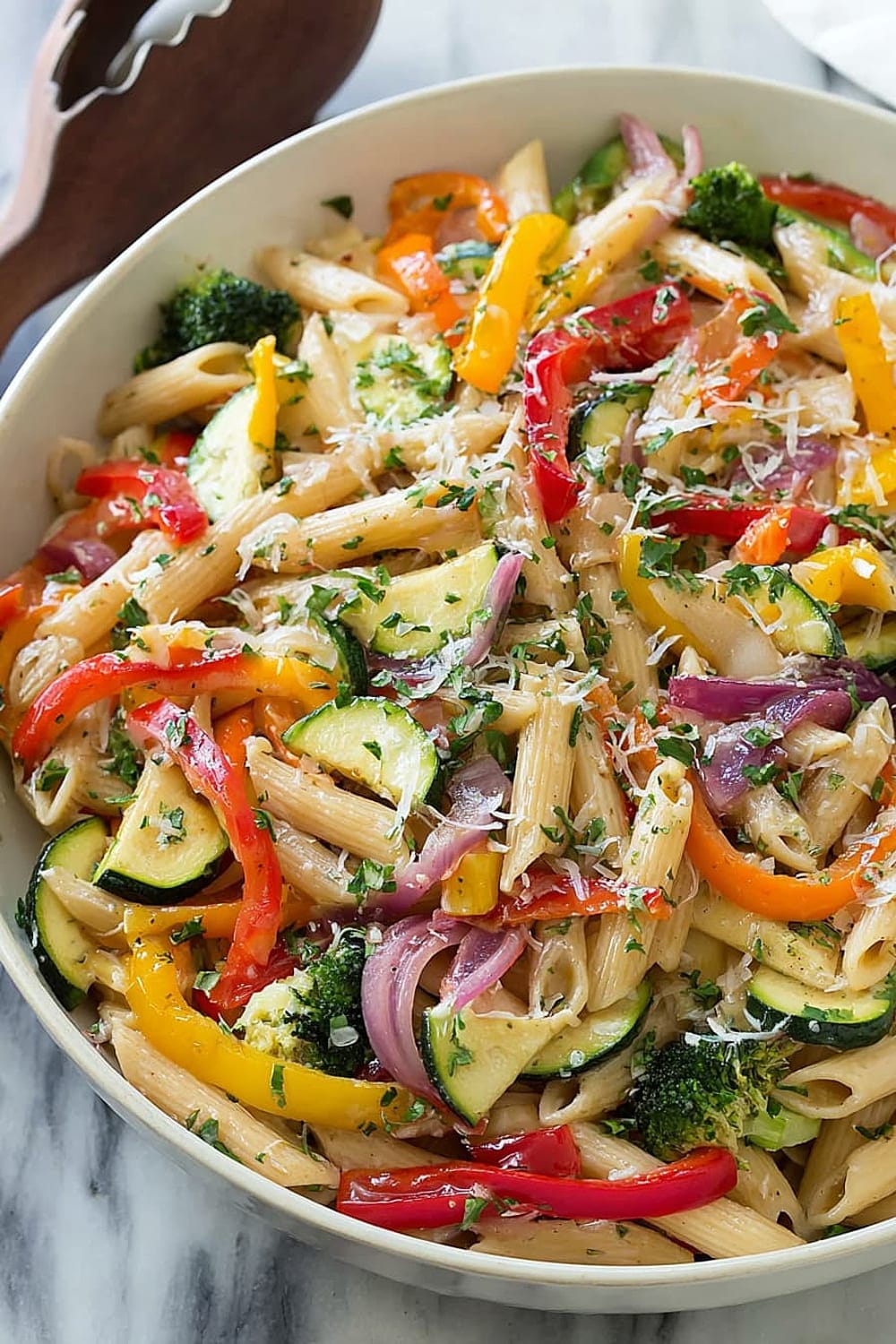
Make It Diabetes-Friendly
Carb Reduction Strategies:
- Replace 10 oz. regular pasta with 6 oz. whole wheat pasta plus 2 large spiralized zucchini to reduce carbs by approximately 30g per serving
- Use shirataki noodles (2-3 packages) instead of pasta to slash carbs from 58g to 12g per serving
- Try palmini noodles made from hearts of palm for a 45g carb reduction while maintaining pasta-like texture
Portion & Timing Tips:
- Reduce serving size to 4/5 of original recipe and pair with 4 oz. grilled protein to maintain satiety
- Estimated 42g net carbs per full serving, 34g net carbs with whole wheat modification
- Add 2 tablespoons chopped walnuts or 1/4 cup cannellini beans for protein and fiber to slow glucose absorption
- Serve as a side dish (1/2 serving) alongside grilled chicken or fish for 17g carbs
Blood Sugar Management:
- The high fiber content from vegetables helps slow carbohydrate absorption
- Olive oil and cheese provide healthy fats that further moderate blood sugar response
- Lemon juice may help improve insulin sensitivity when consumed with carbohydrates
- Consider eating this meal earlier in the day when insulin sensitivity is typically higher
Total Carb Reduction Potential: Up to 75% reduction using shirataki noodles, bringing net carbs to approximately 15g per serving
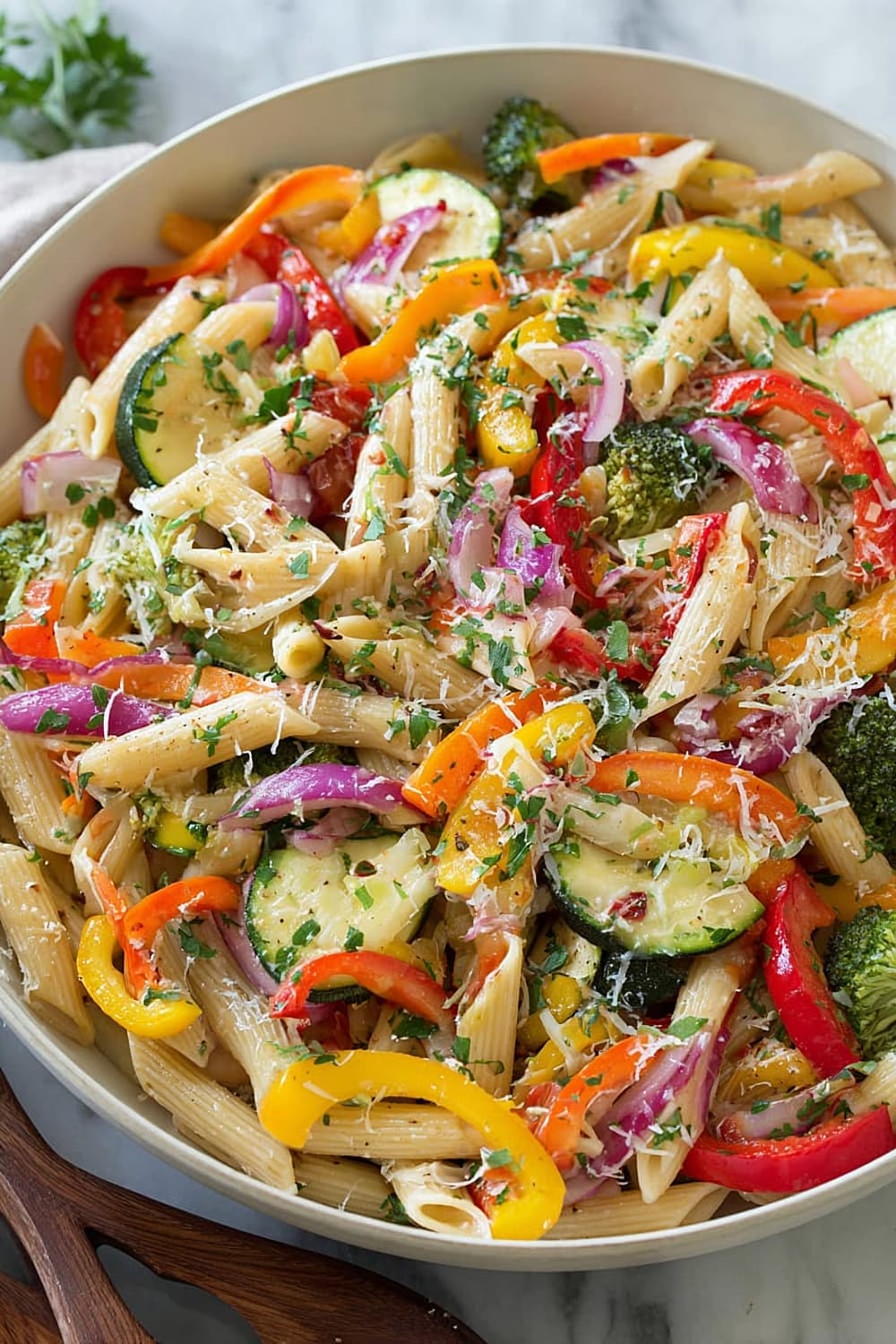
Perfect Pairing Suggestions
Wine and Beverage Pairings
This bright, vegetable-forward pasta pairs beautifully with Pinot Grigio or Sauvignon Blanc – their crisp acidity complements the lemon and fresh vegetables without overwhelming the delicate flavors. For red wine lovers, a light Chianti Classico or Barbera d’Asti provides enough body to match the pasta while enhancing the tomato and herb flavors. Non-alcoholic options include sparkling water with lemon and fresh herbs, iced green tea, or a refreshing cucumber mint agua fresca that echoes the garden-fresh theme.
Side Dish Recommendations
Complement this vegetable-rich pasta with warm crusty bread or garlic focaccia for sopping up any remaining sauce. A simple arugula salad with lemon vinaigrette adds peppery contrast and additional greens. Roasted asparagus or grilled zucchini extends the vegetable theme while providing different textures. For heartier appetites, Italian-seasoned grilled chicken or pan-seared salmon transforms this into a complete protein-rich meal.
Complete Meal Ideas
Start with bruschetta topped with fresh tomatoes and basil to set the Italian mood. Follow the pasta with a light tiramisu or lemon panna cotta for dessert. For entertaining, serve antipasto platters with olives, cured meats, and cheeses as appetizers, then finish with gelato and biscotti for an authentic Italian dining experience.
Seasonal and Occasion Suggestions
This recipe shines during spring and summer when vegetables are at peak freshness, making it perfect for outdoor dining, potluck gatherings, or casual dinner parties. It’s excellent for Meatless Monday meals or weekend meal prep since it reheats beautifully and tastes even better the next day.
Pro Tips and Troubleshooting
Professional Cooking Techniques
The key to restaurant-quality pasta primavera lies in proper vegetable sequencing – add harder vegetables like carrots first, then progressively add softer ones. This ensures everything finishes cooking simultaneously with perfect texture. Salt your pasta water generously – it should taste like seawater. This is your only chance to season the pasta itself. Reserve pasta water before draining – this starchy liquid is essential for creating a silky sauce that binds everything together.
Common Mistakes and Solutions
Overcrowded pan leads to steamed vegetables instead of properly sautéed ones. If doubling the recipe, use two pans or cook vegetables in batches. Overcooked vegetables become mushy and lose their vibrant color – aim for crisp-tender texture. Dry pasta results from not using enough pasta water or adding it too quickly. Add pasta water gradually while tossing to achieve the perfect consistency.
Storage and Make-Ahead Strategies
Refrigerate leftovers for up to 4 days in airtight containers. Reheat gently in a skillet with a splash of water or broth to restore moisture. Meal prep tip: Cook vegetables and pasta separately, then combine when reheating for better texture. Freezing isn’t recommended as the vegetables become watery, but the sauce base can be frozen for up to 3 months.
Scaling and Presentation
When doubling the recipe, use a large roasting pan for final mixing if your pasta pot isn’t large enough. Halving the recipe works perfectly for 2-3 servings. For elegant presentation, warm serving bowls in a 200°F (95°C) oven for 5 minutes before plating. Garnish with additional fresh herbs and a drizzle of high-quality olive oil for restaurant-style finishing.
This pasta primavera proves that eating your vegetables doesn’t have to feel like a punishment – it can be the highlight of your entire day, and your taste buds will thank you for every single bite.